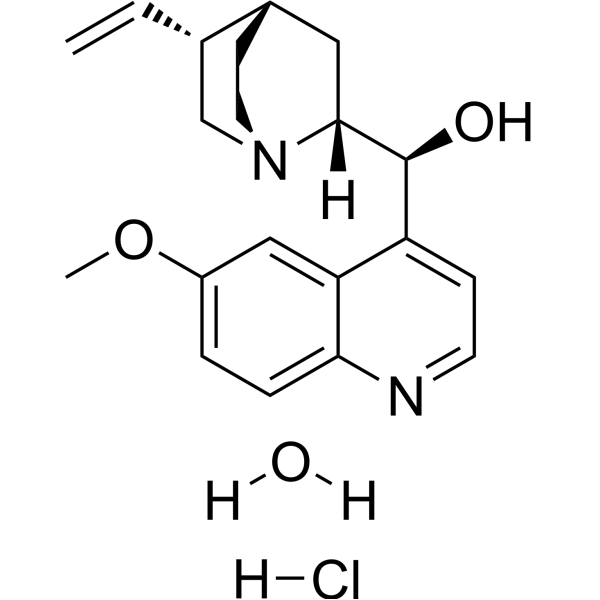Home
Products
Quinidine sulfate



| Product Name | Quinidine sulfate |
| Price: | Inquiry |
| Catalog No.: | CN00570 |
| CAS No.: | 50-54-4 |
| Molecular Formula: | C20H26N2O6S |
| Molecular Weight: | 422.5 g/mol |
| Purity: | >=98% |
| Type of Compound: | Alkaloids |
| Physical Desc.: | Powder |
| Source: | The barks of Cinchona ledgeriana |
| Solvent: | Chloroform, Dichloromethane, Ethyl Acetate, DMSO, Acetone, etc. |
| SMILES: |
| Contact us | |
|---|---|
| First Name: | |
| Last Name: | |
| E-mail: | |
| Question: | |
| Description | Quinidine Monosulfate is an antiarrhythmic agent. Quinidine Monosulfate is a potent, orally active, selective cytochrome P450db inhibitor. Quinidine Monosulfate is also a K+ channel blocker with an IC50 of 19.9 μM. Quinidine Monosulfate can be used for malaria research[1][2][3]. |
| In Vitro | Quinidine is an anti-arrythmic drug which affects ionic currents in heart muscle and which has also been shown to be a potent blocker of several classes of K+ channel in a variety of cell types[1]. Bath application of quinidine causes a dose-dependent reduction of the peak amplitude of Ik. The Kd for blockade of Ik at 0 mV is estimated to be 41 μM[1]. Quinidine elicits a dose-dependent increase of the rate of the decay of Ik and this effect is enhanced by membrane depolarization. Quinidine also causes a 5 mV hyperpolarizing shift of the steady-state inactivation curve and increases the half-time for recovery from inactivation. Quinidine does not affect the onset of inactivation measured at -30 mV[1]. |
| In Vivo | Quinidine sulfate is rapidly absorbed, with peak plasma concentrations 60-90 min after an oral dose. Other salts (gluconate, polygalacturonate) are more slowly absorbed, with lower peak concentrations[2]. Quinidine is approximately 70-90 % bound to plasma proteins. It undergoes hepatic oxidative metabolism to form an N-oxide, a 3-hydroxy form, an O-demethyl form and 2'-quinidinone. Over one-half of patients starting quinidine stop within the first year of therapy because of side effects. These include, commonly, diarrhea, nausea, and vomiting which are not necessarily related to high plasma concentrations[2]. Quinidine inhibits metabolism of amphetamine in rats. Quinidine pretreatment results in a significant decrease in the excretion of p-hydroxyamphetamine at 24 and 48 h to 7.2 and 24.1% of the vehicle-control levels, respectively, accompanied by a significant increase in amphetamine excretion between 24 and 48 h to 542% of the control[3]. |
| Boiling Point | 495.9ºC at 760mmHg |
| Flash Point | 253.7ºC |
| Exact Mass | 746.33500 |
| PSA | 174.16000 |
| LogP | 6.65020 |